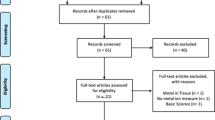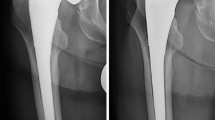Abstract
Introduction
In total hip endoprosthetics and consequently for TDA, metal-on-metal combinations are used with the aim of reducing wear debris. In metal-on-metal TDA the release of metal ions has until now been secondary to the main discussion.
Materials and methods
In order to investigate the ion release following the implantation of the metal-on-metal Maverick™ type artificial lumbar disc we measured the serum cobalt and chromium concentration following implantation of 15 Maverick™ TDAs (monosegmental L5/S1, n = 5; bisegmental L4/5 and L5/S1, n = 5; average age 36.5 years).
Five healthy subjects (no metal implants) acted as a control group. The two measurements of the metals were carried out using the absorption spectrometry after an average of 14.8 and 36.7 months.
Results
In summary, the concentrations of cobalt and chromium ions in the serum at both follow-ups amounted on average to 3.3 μg/l (SD 2.6) for cobalt and 2.2 μg/l (SD 1.5) for chromium.
These figures are similar to the figures shown in the literature following the implantation of metal-on-metal THA.
After a comparison to the control group, both the chromium and cobalt levels in the serum showed visible increases regarding the first and the second follow-up.
Discussion
As there is still a significant release of cobalt and chromium into the serum after an average follow-up of 36.7 months a persistent release of these ions must be taken into consideration.
Despite the evaluation of the systemic and local effects of the release of Cr/Co from orthopaedic implants has not yet been concluded, one should take into consideration an explanation given to patients scheduled for the implantation of a metal-on-metal TDA about these results and the benefits/risks of alternative combinations of gliding contact surfaces.



Similar content being viewed by others
Reference
Allen MJ, Myer BJ, Millett PJ, Rushton N (1997) The effects of particulate cobalt, chromium and cobalt–chromium alloy on human osteoblast-like cells in vitro. J Bone Joint Surg Br 79(3):475–482
Barceloux DG (1999) Chromium. J Toxicol Clin Toxicol 37:173–216
Brodner W, Bitzan P, Meisinger V, Kaider A, Gottsauner-Wolf F, Kotz R (2003) Serum cobalt levels after metal-on-metal total hip arthroplasty. J Bone Joint Surg Am 85-A(11):2168–2173
Brodner W, Grohs JG, Bitzan P, Meisinger V, Kovarik J, Kotz R (2000) Serum cobalt and serum chromium level in 2 patients with chronic renal failure after total hip prosthesis implantation with metal–metal gliding contact. Z Orthop Ihre Grenzgeb 138(5):425–429 Article in German
Elwood JC (1993) Chrom (Chromium). In: Zumkley H (ed) Spurenelemente (Trace elements). Georg Thieme Verlag Stuttgart, New York
Ewers WM (2007) Diagnostik der inneren Exposition (Human-Biomonitoring) [Diagnosis of internal exposure (human biomonitoring)]. In: Wichmann HE, Schlipköter HW, Füllgraf G (eds) Handbuch der Umweltmedizin (Handbook of environmental medicine), 22nd edn. Ecomed Verlag, Landsberg, Chap. III-2.1
Francois J, Coessens R, Lauweryns P (2007) Early removal of a Maverick disc prosthesis: surgical findings and morphological changes. Acta Orthop Belg 73(1):122–127
Gleizes V, Poupon J, Lazennec JY, Chamberlin B, Saillant Q (1999) Value and limits of determining serum cobalt levels in patients with metal on metal articulating prostheses. Rev Chir Orthop Reparatrice Appar Mot 85:217–225 In French.
Hart AJ, Hester T, Sinclair K, Powell JJ, Goodship AE, Pele L, Fersht NL, Skinner J (2006) The association between metal ions from hip resurfacing and reduced T-cell counts. J Bone Joint Surg Br 88(4):449–454
Hellier WG, Hedman TP, Kostuik JP (1992) Wear studies for development of an intervertebral disc prosthesis. Spine 17(6 Suppl):86–96
Huk OL, Catelas I, Mwale F, Antoniou J, Zukor DJ, Petit A (2004) Induction of apoptosis and necrosis by metal ions in vitro. J Arthroplasty 19(8 Suppl 3):84–87
Jacobs JJ, Skipor AK, Doorn PF, Campbell P, Schmalzried TP, Black J, Amstutz HC (1996) Cobalt and chromium concentrations in patients with metal on metal total hip replacements. Clin Orthop Relat Res (329 Suppl):256–263
Jacobs JJ, Hallab NJ, Skipor AK, Urban RM (2003) Metal degradation products: a cause for concern in metal–metal bearings? Clin Orthop 417:139–147
Ladon D, Doherty A, Newson R, Turner J, Bhamra M, Case CP (2004) Changes in metal levels and chromosome aberrations in the peripheral blood of patients after metal-on-metal hip arthroplasty. J Arthroplasty 19(8 Suppl 3):78–83
Lee PTH, Clarke TM, Syracuse NY et al (2004) Serum metal levels after bilateral metal-on-metal total hip arthroplasty. American Academy of Orthopedic Surgeons, Paper No. 097, March 11
Lhotka C, Szekeres T, Steffan I, Zhuber K, Zweymuller K (2003) Four-year study of cobalt and chromium blood levels in patients managed with two different metal-on-metal total hip replacements. J Orthop Res 21(2):189–195
Maezawa K, Nozawa M, Matsuda K, Yasuma M, Mori K, Enomoto F, Ogawa S, Shitoto K, Kurosawa H (2004) Chronological changes of serum chromium levels after modern metal-on-metal total hip arthroplasty. Acta Orthop Scand 75(4):422–426
Masse A, Bosetti M, Buratti C, Visentin O, Bergadano D, Cannas M (2003) Ion release and chromosomal damage from total hip prostheses with metal-on-metal articulation. J Biomed Mater Res B Appl Biomater 67(2):750–757
Mathews HH, Lehuec JC, Friesem T, Zdeblick T, Eisermann L (2004) Design rationale and biomechanics of Maverick Total Disc arthroplasty with early clinical results. Spine J 4(6 Suppl):268S–275S
Rawlinson JJ, Punga KP, Gunsallus KL, Bartel DL, Wright TM (2007) Wear simulation of the ProDisc-L disc replacement using adaptive finite element analysis. J Neurosurg Spine 7(2):165–173
Schaffer AW, Pilger A, Engelhardt C, Zweymueller K, Ruediger HW (1999) Increased blood cobalt and chromium after total hip replacement. J Toxicol Clin Toxicol 37(7):839–844
Skipor AK, Pattcreon LM, Gitells S, Berger RA, Jacobs JJ (2002) Metal ion levels in patients with metal-on-metal total hip replacements. Read at the Annual Meeting of the American Academy of Orthopaedic Surgeons; February 13–17, Dallas. TX
Kim Y-J, Kassab F, Berven S-H et al (2005) Serum levels of nickel and chromium after instrumented posterior arhrodesis. Spine 30:8
Vendittoli PA, Mottard S, Roy AG, Dupont C, Lavigne M (2007) Chromium and cobalt ion release following the Durom high carbon content, forged metal-on-metal surface replacement of the hip. J Bone Joint Surg Br 89(4):441–448
Versieck J (1983) Cobalt. In: Zumkley H (ed) Spurenelemente (Trace elements). Georg Thieme Verlag Stuttgart, New York
Witzleb WC, Ziegler J, Krummenauer F, Neumeister V, Guenther KP (2006) Exposure to chromium, cobalt and molybdenum from metal-on-metal total hip replacement and hip resurfacing arthroplasty. Acta Orthop 77(5):697–705
Zeh A, Planert M, Siegert G, Lattke P, Held A, Hein W (2007) Release of cobalt and chromium ions into the serum following implantation of the metal-on-metal Maverick-type artificial lumbar disc (Medtronic Sofamor Danek). Spine 32(3):348–352
Author information
Authors and Affiliations
Corresponding author
Rights and permissions
About this article
Cite this article
Zeh, A., Becker, C., Planert, M. et al. Time-dependent release of cobalt and chromium ions into the serum following implantation of the metal-on-metal Maverick™ type artificial lumbar disc (Medtronic Sofamor Danek). Arch Orthop Trauma Surg 129, 741–746 (2009). https://doi.org/10.1007/s00402-008-0677-8
Received:
Published:
Issue Date:
DOI: https://doi.org/10.1007/s00402-008-0677-8




